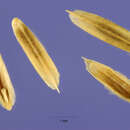Comprehensive Description
(
englanti
)
tarjonnut North American Flora
Leptochloa dubia (H.B.K.) Nees, Syll. PI. Nov. 1:4. 1824
Chloris dubia H.B.K. Nov. Gen. & Sp. 1: 169. 1816.
I.eptoslachys dubia G. Meyer, Fl. Esscq. 74. 1818. (Based on Chloris dubia H.B.K.)
Festuca oblusijlora Willd.; Spreng. Syst. 1: 356. 1825. (Type from Mexico.)
Schismus palens l'resl,Re.Haen]i. I: 269. 1830. (Type from Chile, Haenie.)
Leptochloa patens Kuntli.Rtv. Cram. Supp.XXll. 1830. (Hiised on Schismus patens VrQs.)
Diplachne patens Desv. in C. Gay. Hist. Chile Bot. 6; 371. 1853. (Based on .Schismus patens Pr:sl.)
Uralepis brevicuspidala Buckl. Proc. Acad. IMiila. 1862; 93. 1862. (Type from Texas, Wright 767.)
Ipnum mendocinum I'hilippi, Anal. Univ. Chile 36; 211. 1870. (Type from Mundo/.a, Argenluia.)
Diplachne dubia Scribn. Bull. Torrey Club 10; 30. 1K83. (Based on Leptochloa dubia Ntcs.)
Leptochloa PringUi Bcal, Grasses N. Am. 2: 436. 1896. (Type from Arizona, I'ringle ni 1884.) Diplachne mendocina Kurtz, Bol. Acad. Ci. C6rdoba 15: 521. 1897. (Based on Ipnuni niendocinum
Philippi.) Diplachne diibia var. Hiimboldtiana Kuntze, Rev. Gen. PI. 3': 349. 1898. (Type from Mexico.) Diplachne dubia var. Kurtziana Kuntze, Rev. Gen. i': 349. 1898. (Type from Argentina, Kurtz
6647.) Diplachne dubia var. Pringleana Kuntze, Rev. Gen. 3': 349. 1898. (Type from Chihuahua, Mexico,
Pringle 423.) Leptochloa dubia var. f ri«g!faHaScribn.& Merr. Bull. U. S. Dep. Agr. Agrost . 24: 27. 1901. (Based
on Diplachne dubia var. Pringleana Kuntze.) Rabdochloa dubia Kuntze; Stuck. Anal. Mus. Nac. Buenos Aires III. 4: 121. 1904. (Based on
Leptochloa dubia Nees.) Sieglingia dubia Kuntze; Stuck. Anal. Mus. Nac. Buenos Aires III. 4: 128. 1904. (Based on
Chloris dubia H.B.K.) Eragroslis mendocina Jedw. Bot. Archiv. S: 192. 1924. (Based on Ipnum mendocinum Philippi.)
Perennial; culms in dense, rather tough clumps, erect, simple or branching, 40 cm. to more than a meter tall, glabrous; sheaths mostly shorter than the internodes, glabrous, or sparsely pilose on the margins, at least the lower ones keeled, the upper ones rounded on the back; ligule I mm. long, minutely lacerate; blades flat, 10-25 cm. long (or the uppermost shorter), 2-6 mm. wide, scabrous, often pilose on the upper surface near the base; inflorescence 8-20 cm. long, with several ascending to spreading, scattered spikes, the lower ones 8-10 cm. long; spikelets 4-10-flowered, the florets spreading; glumes acuminate, the first 3 mm. long, the second a little broader, 3.5-4 mm. long; lemma 3 mm. long, awnless, minutely pubescent on the margins, sparsely pilose on the internerves, the tip with two broad rounded lobes.
Type uoc.m.itv: Mexico (Humboldt b" Bonpland).
DrsTRTBUTioN: Dry rocky hills and open ground, southern Florida; Oklahoma and Texas to Arizona, and southward through Mexico; also in Argentina.
- bibliografinen lainaus
- Albert Spear Hitchcock, Jason Richard Swallen, Agnes Chase. 1939. (POALES); POACEAE (pars). North American flora. vol 17(8). New York Botanical Garden, New York, NY
Physical Description
(
englanti
)
tarjonnut USDA PLANTS text
Perennials, Terrestrial, not aquatic, Stems nodes swollen or brittle, Stems erect or ascending, Stems geniculate, decumbent, or lax, sometimes rooting at nodes, Stems caespitose, tufted, or clustered, Stems terete, round in cross section, or polygonal, Stems compressed, flattened, or sulcate, Stems branching above base or distally at nodes, Stem internodes hollow, Stems with inflores cence less than 1 m tall, Stems with inflorescence 1-2 m tall, Stems, culms, or scapes exceeding basal leaves, Leaves mostly cauline, Leaves conspicuously 2-ranked, distichous, Leaves sheathing at base, Leaf sheath mostly open, or loose, Leaf sheath smooth, glabrous, Leaf sheath hairy at summit, throat, or collar, Leaf sheath and blade differentiated, Leaf blades linear, Leaf blades 2-10 mm wide, Leaf blades mostly flat, Leaf blade margins folded, involute, or conduplicate, Leaf blades mostly glabrous, Leaf blades more or less hairy, Ligule present, Ligule an unfringed eciliate membrane, Inflorescence terminal, Inflorescence solitary, with 1 spike, fascicle, glomerule, head, or cluster per stem or culm, Inflorescence a panicle with narrowly racemose or spicate branches, Inflorescence a panicle with digitately arranged spicate branches, Inflorescence with 2-10 branches, Inflorescence branches more than 10 to numerous, Inflorescence branches 1-sided, Inflorescence branches pa ired or digitate at a single node, Flowers bisexual, Spikelets sessile or subsessile, Spikelets laterally compressed, Spikelet less than 3 mm wide, Spikelets solitary at rachis nodes, Spikelets all alike and fertille, Spikelets bisexual, Spikelets disarticulating above the glumes, glumes persistent, Spikelets disarticulating beneath or between the florets, Spikelets secund, in rows on one side of rachis, Rachilla or pedicel glabrous, Glumes present, empty bracts, Glumes 2 clearly present, Glumes distinctly unequal, Glumes shorter than adjacent lemma, Glumes keeled or winged, Glumes 1 nerved, Lemmas thin, chartaceous, hyaline, cartilaginous, or membranous, Lemma 3 nerved, Lemma body or surface hairy, Lemma apex dentate, 2-fid, Lemma awnless, Lemma mucronate, very shortly beaked or awned, less than 1-2 mm, Lemma straight, Palea present, well developed, Palea membranous, hyaline, Palea about equal to lemma, Palea 2 nerved or 2 keeled, Stamens 3, Styles 2-fid, deeply 2-branched, Stigmas 2, Fruit - caryopsis.
Disakisperma dubium: Brief Summary
(
englanti
)
tarjonnut wikipedia EN
Disakisperma dubium is a species of grass known by the common names green sprangletop and zacate gigante. It is native to the Americas, where it is distributed from the United States to Argentina.
This perennial grass grows up to 110 centimeters tall. The leaves are up to 35 centimeters long and are hairless to hairy or rough in texture. The leaf sheaths are sometimes purplish. The inflorescence is a branching panicle with brown or greenish spikelets.
This grass is a good forage for animals and it is sometimes added to seed mixes used for vegetating rangeland.
- lisenssi
- cc-by-sa-3.0
- tekijänoikeus
- Wikipedia authors and editors

